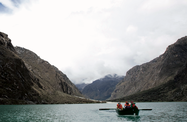Meeting Peru’s tourism targets needs help from infrastructure projects
Both the government and private sector leaders would like to see Peru’s tourism industry, already an important part of the economy, continue to expand over the next decade. However, challenges such as poor infrastructure will need to be addressed to sustain growth in the long run.
Tourism generates around $3.3bn in income each year, or 8% of GDP. The National Chamber of Tourism (Cámara Nacional de Turismo, Canatur) and the Ministry of Foreign Trade and Tourism (Ministerio de Comercio Exterior y Turismo, Mincetur) expect this figure to rise to $10bn by 2021.
To support this expansion, Canatur hopes to welcome 5.1m international tourists annually by 2021, nearly double the 2.6m received in 2011. Domestic tourism, which is on the rise, may also help the industry meet growth projections. According to Mincetur, domestic travellers accounted for 34.9m trips in 2012, with this figure expected to rise to more than 36m in 2013.
A recent study by the Commission to Promote Peruvian Exports and Tourism revealed that spending on domestic tourism is also on the rise. In 2012 Peruvians spent an average of PEN497 ($187) per trip, which marked an 8% increase over spending in 2011.
Tourism could be the top economic sector in terms of employment and foreign currency earnings within 20 years, according to Carlos Canales, the president of Canatur. Canales, who was commenting on the outcome of the World Travel Awards for Central and South America, which was hosted by Peru in late July, based his projections on studies by the National Centre for Strategic Planning and Peru’s University of the Pacific.
However, to sustain growth and meet long-term objectives, additional investments will be necessary, José Luis Silva, the then-minister of foreign trade and tourism, told local press earlier in July. Silva noted specifically the need for new hotels, adding that the country must improve its international air connections and host more meetings and conferences.
The new Cerro Juli Convention Centre, which is being built in Arequipa in southern Peru to host the Perumin Mining Convention, may help attract more event organisers to the South American country. Cerro Juli will have the capacity to accommodate 2300 booths and is expected to receive as many as 70,000 visitors during the Perumin conference in September.
While projects like the Cerro Juli Convention Centre indicate that Peru is on the right track, there are several challenges that could stand in the way of reaching the scale of tourism envisioned by Mincetur and Canatur. The “The Peru Travel & Tourism Competitiveness Report 2013”, published by the World Economic Forum (WEF), cites several of these issues.
Peru’s transportation infrastructure is inadequate. While the Jorge Chávez International Airport in Lima was recently recognised as the best airport in South America by the World Travel Awards, it is in need of expansion. Nonetheless, plans to build a second runway were recently postponed until 2020, after the Ministry of Transport and Communications failed to successfully deliver the land needed to implement the project to Lima Airport Partners, the airport operator.
In the interior of the country, many airports cannot accommodate wide-bodied jets. Furthermore, highway infrastructure is also lacking, although the Ministry of Transport and Communications is focused on upgrading and expanding the road network.
The WEF also emphasised the need to develop better safeguards for the country’s rich natural resources, which attract many tourists to Peru. While there is legislation in place to protect the natural environment and Peruvians in general acknowledge the need to do so, the WEF said that “the natural environment continues to be degraded” because of unsustainable agricultural activities, mining and logging. Protecting the vibrant and diverse flora and fauna would prove to be a smart investment in the future of the industry.


